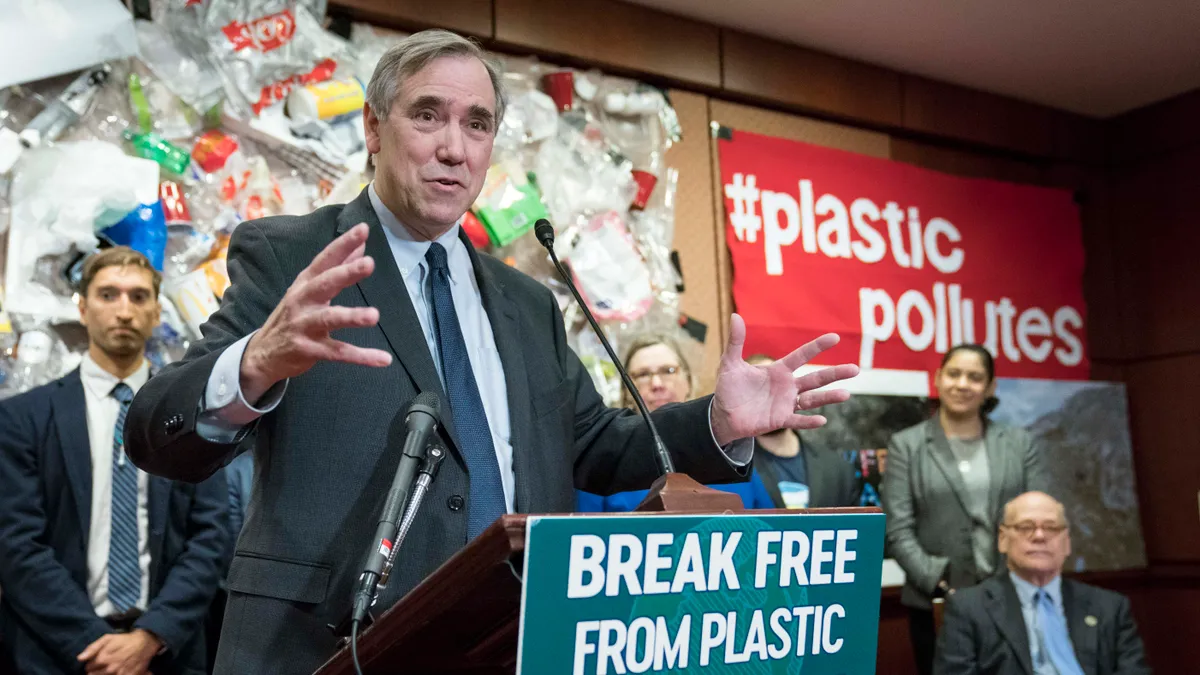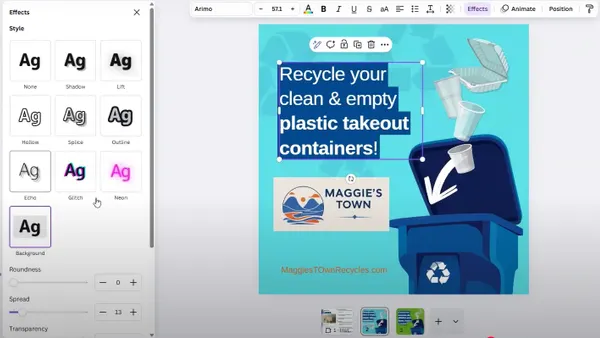Dive Brief:
- U.S. House and Senate Democrats reintroduced the Break Free from Plastic Pollution Act on Wednesday, led by Sen. Jeff Merkley, D-Ore., and Rep. Jared Huffman, D-Calif. Dozens of environmental groups support the bill, while plastics industry groups again voiced staunch opposition.
- The bill aims to reduce plastic production and rein in plastic waste. Provisions include creating a nationwide deposit return system as well as establishing extended producer responsibility for makers of beverage containers and certain plastic products.
- Bill sponsors highlighted elements that “strengthened” this year’s version, which they say include requiring all single-use beverage containers and packaging to be reusable, recyclable or compostable; “robust requirements” for incorporating postconsumer recycled content in beverage containers; and “stronger language” on eliminating toxic substances in beverage containers.
Dive Insight:
The bill revives and updates legislation that was previously introduced in 2020 and 2021 and failed to advance. Merkley’s announcement Wednesday described it as “the most comprehensive plan ever introduced in Congress to address the plastic pollution crisis.”
The bill introduced Wednesday is “even more extreme than previous versions that failed legislatively,” said Ross Eisenberg, who leads the American Chemistry Council’s plastics division, in a statement. ACC said in a press release it continues to work with members of Congress to introduce legislation that would require U.S. plastic packaging to have at least 30% recycled content by 2030, along with other recycling provisions.
The Plastics Industry Association also slammed the bill, calling it “even worse and less collaborative” than prior versions. “We believe there are answers to the environmental challenges we face, such as investments in recycling infrastructure and greater demand for recycled content through minimum requirements and stronger end-markets,” said CEO Matt Seaholm.
The Ocean Conservancy is one of numerous supporters, praising the bill’s alignment with SB 54, California’s EPR law, on plastic source reduction and producer-funded cleanup efforts.
The bill’s many provisions that could impact packaging and recycling stakeholders include:
- Establishing EPR: The legislation would establish an extended producer responsibility system for beverage containers and packaging. Producer responsibility organizations would need to get product stewardship plans approved by the U.S. EPA.
- Targeting source reduction: For single-use plastic products and beverage containers covered under EPR, the source reduction targets are 25% by weight and plastic component by 2032, 40% by 2040 and 50% by 2050. All such products would need to be reusable, recyclable or compostable by 2033.
- Increasing recycled content: Plastic beverage containers would have to include at least 15% PCR from U.S. sources by 2025, 30% by 2030, 45% by 2030 and 60% by 2040.
- Reporting on the three Rs: The legislation would compel EPA to, every five years, conduct a needs assessment analyzing barriers and opportunities for reducing, reusing and recycling covered products and beverage containers. On that same cadence, EPA would publish a report on reuse/refill system best practices.
- Creating a national bottle bill: Producers of beverage containers of any material would be required to have at least a 10-cent refund price on each container. A PRO would re-invest unclaimed deposits in recycling infrastructure. States with existing bottle bills could maintain their own programs or join the federal system. Senators discussed the potential for a national bottle bill at a subcommittee hearing last month.
- Prohibiting certain toxic substances: Within four years of enactment, the legislation would block producers from selling packaging with toxic substances, which could include per-and polyfluoroalkyl substances, a bisphenol compound or orthophthalates, among others.
- Banning certain plastics and products: The sale or provision of single-use plastic bags and of black plastic food service ware would be banned one year post-enactment. Polystyrene foam food service products would be banned after 18 months. Reusable plastic or single-use paper bags would come with a minimum 10-cent fee.
- Standardizing labeling for receptacles: The bill calls for guidelines to nationally standardize labeling for recycling and composting receptacles.
- Restricting chemical recycling: The bill would restrict the EPA’s National Recycling Strategy from including facilities that process plastic waste through chemical recycling. Certain lawmakers and environmental groups have criticized EPA’s consideration of those technologies.
- Limiting plastic pollution from facilities: To limit pollution in waterways, the bill would compel EPA to prohibit the discharge of plastic pellets and other pre-production plastic from facilities that make, use, package or transport pellets.
- Grant opportunities: The bill would establish competitive grants for reuse and refill projects, with an emphasis on expanding equitable access and non-toxic materials. To reduce or eliminate single-use plastics in agriculture, the bill would also spur grants to help transform post-production distribution packaging.
The bill takes into account state and local laws on many of these issues — for instance, restrictions on hospitality establishments’ small personal care bottles or making single-use utensils and other food service ware available by request only — saying it will not preempt any such laws that enact more stringent standards, requirements or bans.
Another key aim of the bill is to reduce plastics’ and plastics production’s health and environmental impacts on frontline and fenceline communities. The legislation encompasses the proposed Protecting Communities from Plastics Act, which includes requirements on plastic production and chemical recycling facilities to protect environmental justice concerns.
Other packaging or recycling-related bills have not moved in Congress’ current session.
Interested in more packaging news? Sign up for Packaging Dive’s newsletter today.












